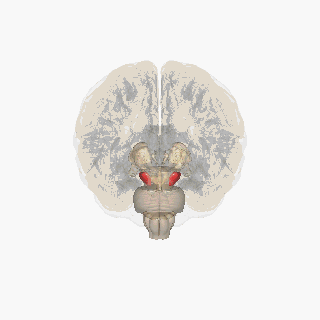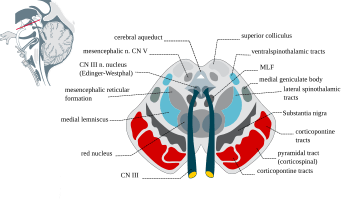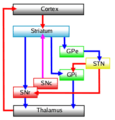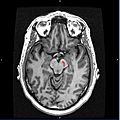Substantia nigra facts for kids
| Brain: Substantia nigra | ||
|---|---|---|
Quick facts for kids
|
||
| Substantia nigra highlighted in red. | ||
| Section through superior colliculus showing Substantia nigra. | ||
| Latin | Substantia nigra | |
| Part of | Midbrain, Basal ganglia | |
The substantia nigra (say "sub-STAN-shee-uh NY-gruh") is a very important part of your brain. It's located in the midbrain, which is like the central control area for many body functions. This special part of the brain is known for making a chemical called dopamine.
Dopamine is super important because it helps control your movement. It makes sure your body can move smoothly and in a coordinated way. When the substantia nigra doesn't make enough dopamine, it can lead to problems with movement, like those seen in Parkinson's disease.
Contents
What is the Substantia Nigra?
The substantia nigra is a small, dark-colored area deep inside your brain. Its name actually means "black substance" in Latin, because it looks darker than other brain areas. This dark color comes from a pigment called neuromelanin, which is related to the dopamine-making process.
This brain part is a key player in a larger system called the basal ganglia. Think of the basal ganglia as a team of brain areas that work together. Their main job is to help you start, stop, and control your movements. The substantia nigra is like the coach of this team, making sure everything runs smoothly.
Two Main Parts
The substantia nigra has two main sections:
- Pars compacta: This part is where most of the dopamine is made. It sends dopamine to other parts of the brain, especially to an area called the striatum. This connection is vital for smooth, controlled movements.
- Pars reticulata: This section acts more like a relay station. It helps send signals from the basal ganglia to other parts of the brain, like the thalamus. This helps fine-tune movements and keep them organized.
How Does it Work?
Imagine you want to pick up a pencil. Your brain sends signals to your muscles to make this happen. The substantia nigra plays a big role in making sure these signals are clear and effective.
When the pars compacta releases dopamine, it helps other brain cells communicate better. This communication is like a well-oiled machine, allowing your movements to be precise and effortless. Without enough dopamine, these signals can become weak or disorganized, leading to shaky movements or difficulty starting to move.
Substantia Nigra and Parkinson's Disease
One of the most well-known connections of the substantia nigra is with Parkinson's disease. This condition happens when the cells in the pars compacta of the substantia nigra start to die off. As these cells disappear, the brain produces less and less dopamine.
When dopamine levels drop too low, people can experience symptoms like:
- Tremors (shaking, often in the hands)
- Stiffness in their limbs
- Slow movements
- Problems with balance
Scientists are always working to understand more about the substantia nigra and how to protect its cells. This research is important for finding new ways to treat Parkinson's disease and other movement disorders.
Images for kids
See also
 In Spanish: Sustancia negra para niños
In Spanish: Sustancia negra para niños








